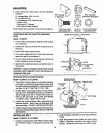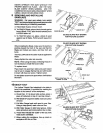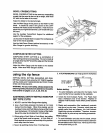
D. Plan your cutto avoid KICKBACKS and THROW-
BACKS -when a partor allof the workpiece binds
on the blade and is thrown violently back toward
the front of the saw.
f. Never cut FREEHAND: Always use either a
Rip Fence, Miter Gauge or fixture to position
and guide the work, so it won't twist,bind onthe
blade and kickback.
2. Make sure there's no debris between the work-
piece and its supports.
3. Whencutting irregularlyshapedworkpieces,
plan your work so it will not slip and pinch the
blade:
a. A piece of molding, for example, must lie flat
or be held by a fixture or jigthat will not let it
twist, rock or slipwhile being cut. Use jigs or
fixtures where needed to prevent workpiece
shifting.
b. Use a different, better suited type of tool for
work that can't be made stable.
4. Use extra caution with large, very small or
awkward workpieces:
a. Use extra supports (tables, saw horses
blocks,etc.) for any workpieces largeenough
to tip when not held down to the table top.
NEVER useanother person as a substitute
for a Table Extension, or as additional sup-
port for a workpiece that is longer or wider
than the basic saw table, or to help feed,
support or pull the workpiece.
b. Neverconfinethepiecebeingcutoff. That is,
the pieceNOT againstthe Fence, MiterGauge
or fixture. Never hold it, clamp it, touch it, or
use lengthstops against it. It must be free to
move. Ifconfined, itcouldgetwedged against
the blade and cause a kickback or throw-
back.
c. Never cut more than one workpiece at atime.
d. Never turn your table saw "ON" before clear-
ing everything except the workpiece and
related support devices off the table.
4. Planthewayyouwill pushtheworkplecethrough.
A. NEVER pug the workpiece through. Start and
finishthe cut from the front of the table saw.
B. NEVER put your fingers or hands in the path of
the sawblade or other cutting tool.
C. NEVER reach in back ofthecuttingtoolwith either
hand to hold-down or support the workpiece,
remove wood scraps, or for any other reason.
D. Avoid awkward operations and hand positions
where a suddenslipcouldcause fingers or handto
move into a sawblade or other cutting tool.
E. DONq" OVERREACH. Always keep good footing
and balance.
F. Push the workpiece against the rotation of the
blade. NEVER feed material into the cutting tool
from the rear of the saw.
G.Always push the workpiece all the way past the
sawblade.
H. As much as possible, keep your face and body to
one sideof the sawblade, out of line with a possible
kickback or throwback.
I. NEVER turn the saw"ON"before clearing the table
of all tools, wood scraps, etc., except the work-
piece and related feed or support devices for the
cut planned.
WHENEVER SAW BLADE IS SPINNING
WARNING: Don't let familiarity (gained from fre-
quent use of your table saw) cause a careless mis-
take. Always remember that a careless fraction of a
second is enough to cause a severe injury.
1. Before actually cutting with the saw, watch it while it
runs for a short while. If it makes an unfamiliar noise
or vibrates a lot, stop immediately. Turn the saw off.
Unplugthe saw. Do not restart untiltinding andfixing
the problem.
2. Make sure the top of the arbor or cutting tool turns
toward the front of the saw.
3. Set the cutting tool as low as possible for the cut
you're planning.
4. KEEP CHILDREN AWAY. All visitors should be kept
a safe distance from work. Make sure bystanders are
clear of the saw and workpiece.
5. Let the blade reach full speed before cutting.
6. DON'T FORCE TOOL. It will do the ._obbetter and
safer at its designed rate. Feed the workpiece intothe
blade only fast enough to let it cut without bogging
down or binding.
7. Before freeing any jammed material:
A. Turn switch "OFF".
B. Unplug the saw.
C. Wait for all moving parts to stop.
D. Checkblade, Spreader and Fence for proper align-
ment before starting, again.
8. To avoid throwback of cut off pieces;
A. Use the Guard Assembly.
B. To remove loose pieces beneath ortrapped inside
the Guard:
1; Turn saw "OFF".
2. Remove Switch Key.
3. Wait for blade to stop before lifting the Guard.
29


















